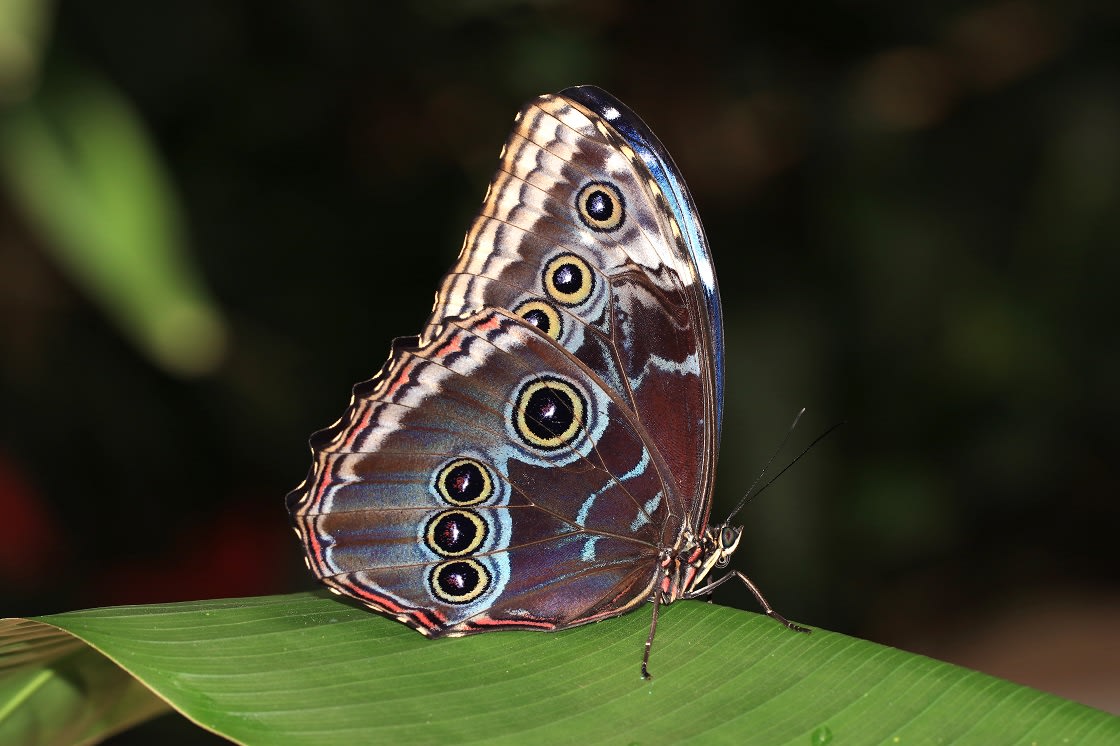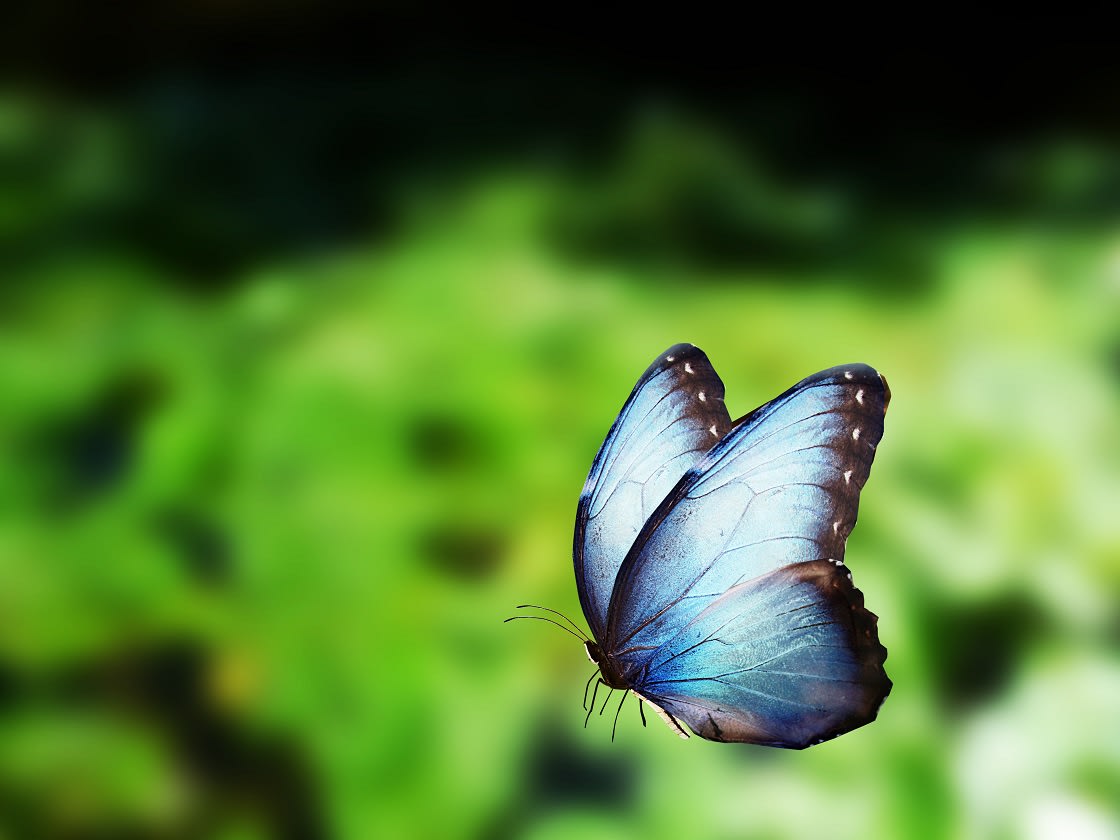
The Amazon rainforest is the most biodiverse environment on Earth, home to an incredible array of captivating creatures that truly have to be seen to be believed. Due to their size and striking beauty, blue morpho butterflies are one of the most emblematic and favorite of all Amazon species. They have a characteristic vivid blue color and shiny wings that reflect the light, making them easy to spot amidst the jungle canopy. They are one of the largest butterflies in the world, measuring around six inches long and with wing spans of up to 20 centimetres. They can be found throughout the forests of South and Central America, especially Brazil, Costa Rica and Venezuela, though their habitat also extends into North America. Read on to learn the top 8 Blue Morpho Butterfly facts…
The name “blue morpho” can actually be used to refer to any blue butterfly of the genus “morpho” which are part of the larger Nymphalidae family. There are also numerous other morpho species, which number 29 in total, including the brown, green and incredibly rare white butterflies. The name “morpho” is thought to originate from the fact that these butterflies appear to change shape as they’re flying. What’s more, the term “blue morpho” can actually be a bit of a misnomer because many of the females are not blue at all!

The underside of the butterfly’s wings are covered in shades of brown, red, black and grey
To compensate for their vivid blue colour – which could catch the attention of predators – the underside of the butterfly’s wings are covered in shades of brown, red, black and grey. This resembles the colour and patterning of foliage and helps with camouflage. Their undersides also feature “ocellie” or eyespots which deter predators when the butterflies are at rest and their wings are closed. When threatened, the butterfly will emit a strong odour from a gland on their front legs that functions as another way to repel predators. The blue morpho also has what is known as a “flashing” defence. When in flight, its wings appear to flash from vivid blue to dull brown. The butterfly seems to continuously disappear and reappear again, making it very hard to track through the thick jungle foliage.

Beautiful blue Morpho Helena butterfly (female) with sparkling wings
These butterflies are covered in shimmering shades of blue on their upper wing surfaces. However, it is typically only the males who exhibit this stunning colouration. The bright coloring is designed to intimidate rival males (blue morpho butterflies are highly territorial) as well as to make themselves extra visible to potential mates. Meanwhile, the females are generally not blue at all and tend to have have wings exhibiting various shades of brown, yellow and black. Interestingly, however, due to a process known as sexual dimorphism, there are some rare examples of butterflies with both male and female traits which leads them to have one blue wing and one more neutral-coloured wing.
Turns out the Blue Morpho’s wings are not actually blue at all! Of course, they certainly appear this way, but this is not the result of pigmentation. It is actually caused by the way light reflects off the microscopic scales on its wings. The scales are diamond-shaped and the color results from their specific formation and placement on the wing membranes. This is a phenomenon known as iridescence, a type of optical illusion which describes how hues change according to the angle from which they are viewed.

Their vivid, iridescent blue coloring is a result of the microscopic scales on the backs of their wings, which reflect light
These butterflies are diurnal and most active when the sun is shining. Their eyes are highly sensitive to UV light and the males are particularly adept at spotting each other across great distances. Flying through light-filled environments makes them an especially visible presence as the sun rays are reflected off their shiny wings. In fact, Blue Morpho butterflies are reportedly spotted flying through the jungle canopy by pilots from the air. Luckily for visitors to the Amazon, the butterflies spend most of their time on the forest floor, amongst lower shrubs and trees, flying through clearings or warming themselves next to streams.

They cannot “eat” anything. … Adult Blue Morpho Butterflies drink the juices of rotting fruit
6. Blue Morphos are Unable to Eat
As caterpillars, Blue Morphos start their lives feeding on various plants, particularly those of the pea family. But after transforming they quickly graduate to a more varied and interesting diet, despite the fact they can no longer chew. They drink the juices of rotting or fermenting fruit using their proboscis, a long mouthpart that acts like a straw enabling them to suck up the sweet fluids. They’ve also been known to drink the juices of tree sap, fungi, decomposing animals, and even wet mud. What’s more, Blue Morphos have smell receptors on their antenna and taste sensors on their feet.
Blue Morphos have long been a source of great fascination to humans. Traditionally, the indigenous peoples of the Amazon associated the butterfly with a long list of superstitious beliefs, and they’ve alternatively been considered both wish granters and evil spirits. More recently, their light-reflecting abilities have been of great interest to scientists. Studying the phenomenon closely has allowed us to apply the same technique to various forms of technology, including iridescent strips on bills to prevent counterfeiting and energy-efficient color displays for devices.
Unfortunately, Blue Morphos face many potential predators and threats in their rainforest home. Whilst not directly endangered, like many Amazon species they are threatened by deforestation and habitat fragmentation. Their beauty also makes them a target for those wanting to capture them for artistic or collection purposes, and even to make jewelry out of their wings. Conservation of the Blue Morpho butterfly is ongoing in North American butterfly houses, but to see this stunning creature in its natural environment, there’s no better place than the Amazon!
Did you enjoy these 8 Blue Morpho butterfly facts and fancy witnessing the shimmering beauty of one for yourself? An Amazon river cruise will provide plenty of opportunities to see them on wild treks through the jungle.
While Rainforest Cruises aim to provide accurate and up-to-date information, we make no representations as to the accuracy or completeness of any information herein or found by following any link on this site. Rainforest Cruises cannot and will not accept responsibility for any omissions or inaccuracies, or for any consequences arising therefrom, including any losses, injuries, or damages resulting from the display or use of this information.




